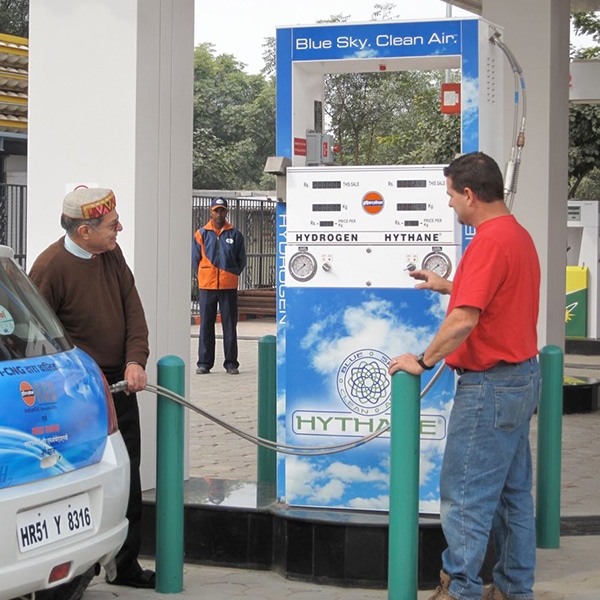Our Innovations




OptiBlend® technology allows your conventional diesel engine to run natural gas as its primary fuel without modifying the engine or the current diesel fuel system. The result? Lower fuel costs, lower emissions, and increased runtime.
OptiBlend® Proprietary Air-Gas Mixer Design and Fuel Control Valve Natural
Gas is delivered to the combustion chamber using the existing air intake system. The OptiBlend® proprietary Air-Gas Mixer (AGM) (far-right) is installed just downstream of the stock air filter where it dictates the air-to-gas ratio in conjunction with the OptiBlend® Fuel Control Valve (FCV)(left). The mixer uses the Venturi effect to draw gas into the engine. The fuel control valve has a 10-20 millisecond reaction time, allowing immediate throttle adjustment in response to changes in engine load. The fuel control valve utilizes internal software with fault detection and position control and is controlled by the Programmable Logic Control (PLC). Each OptiBlend® kit is custom fit and commissioned for your specific engine and application.

EdenPlast® is a CNT enriched polypropylene tape made by conventional extrusion process. The product is made from stable pelleted, high concentration CNT masterbatch diluted with standard PP material, the CNTs end up uniformly dispersed and fully integrated in the PP matrix.
Eden and the University of Queensland are undertaking a collaborative research project into carbon nanotubes in plastics, which has achieved very encouraging preliminary results. The following conclusions, along with full details of the actual results achieved to date with Eden’s new product EdenPlast®, including comparisons with the published performance of other commercial Nylon 6 products, are shown in Figure 1 below.
- Excellent combination of high modulus (stiffness) and outstanding ductility (elongation-at-break) achieved for Nylon containing <1% Eden’s CNTs compared to commercial grades of nano Nylon 6.
- Superior ductility with comparable tensile strength (> 75 MPa, 50% Relative Humidity (“RH”) conditions) compared to super-tough commercial Nylons containing higher levels (4wt%) of nanoclays.
- Higher tensile strength than comparable Nylon based materials with similar ductility.
- Excellent dispersion of the Eden’s CNTs in EdenPlast®(see the two TEM micrographs in Figure 2 below).
- Visual clarity and transparency suggests suitability for a super-tough-film grade.
- The relatively low-cost processing method of EdenPlast® could potentially result in production of cost-effective, high-stiffness and/or high-toughness grades of nano Nylon 6.
- Possible suitable future markets for EdenPlast®, indicated by the results to date, are the automotive and packaging markets.
- Whilst fundamental studies (XRD, rheology, thermal and electrical analysis) and further standard characterization (ASTM, ISO) need to be carried out (impact, flexural, tensile, dynamical, fatigue) before possible commercialization, these preliminary results from extruded filaments are considered very encouraging.
Figure 1. Comparative EdenPlast® Test Performance Results vs Other Published Performance Results (click image to enlarge)
*DAM: Dried as moulded ¥ EdenPlast®– Conditioned at 55-60 % Relative Humidity (RH) values instead at 50%RH, and mechanical characterization of extruded composite filaments of 1.5-2.0 mm in diameter at 25 mm/min, instead of ASTM D638.

To order EdenPlast®, please contact:
[email protected] | (303) 468-1705
EdenPlast® is available in the United States, Internationally, and in Europe.
Other Technologies
Pyrolysis Project & Hythane™
Pyrolysis Project
Carbon Nanotube & Carbon Nanofibre and Hydrogen production from natural gas without producing carbon dioxide. Through the pyrolysis process, developed by Eden with the University of Queensland and which Eden now owns 100%, and has been commercialised in Colorado, USA at Eden innovations LLC facility, methane (natural gas) is broken down into its constituents of hydrogen gas and carbon, without the production of carbon dioxide. The carbon is produced as a solid as either carbon nanofibres or carbon nanotubes that each are many times stronger, in certain applications, than steel, whilst each also has a great a capacity to conduct both electricity and heat.
The Process
- Appears, from information available, to be relatively efficient when compared with other methods of production of carbon nanotubes and fibres, requiring only a relatively low level of energy and lower cost capital equipment compared with most other published methods;
- Employs relatively low cost catalysts (no precious metals are used in the catalysts);
- Low carbon footprint
- Produces only hydrogen together with either carbon nanotubes or solid carbon fibres from natural gas.
- Applications:
Low-cost hydrogen production without the production of carbon dioxide as a by-product that could help facilitate the more rapid spread of both hydrogen as a vehicle fuel and also Eden’s Hythane™ technology as an ultra-clean, highly efficient premium blend of hydrogen and natural gas that it is marketing in India and USA.


Eden Energy CNT/CNF Production

Hythane™
Hythane™ is a blend of hydrogen and Natural Gas that yields significant emission reductions whilst being a cost effective gaseous fuel option. Developed by Frank Lynch, supported by Roger Marmaro, the technology was acquired by Eden in 2004.
Hydrogen and methane are complimentary gaseous vehicle fuels in many ways:
- Methane has a relatively narrow flammability range that limits the fuel efficiency and oxides of nitrogen (NOx) emissions improvements that are possible at lean air/fuel ratios. The addition of even a small amount of hydrogen, however, extends the lean flammability range significantly.
- Methane has a slow flame speed, especially in lean air/fuel mixtures, while hydrogen has a flame speed about eight times faster.
- Methane is a fairly stable molecule that can be difficult to ignite, but hydrogen has an ignition energy requirement about 25 times lower than methane.
- Finally, methane can be difficult to completely combust in the engine or catalyze in exhaust after treatment converters. In contrast, hydrogen is a powerful combustion stimulant for accelerating the methane combustion within an engine, and hydrogen is also a powerful reducing agent for efficient catalysis at lower exhaust temperatures.













